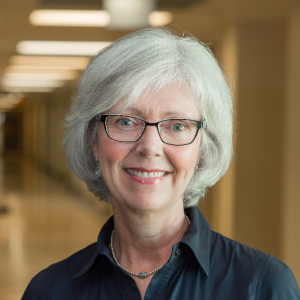MRRI developed its Scientist in Residence program to continue to foster collaborations with exceptional researchers at world-class institutions around the world. Dr. Lyn Turkstra has been a Scientist in Resident at MRRI since July 2019, and she has contributed to a variety of collaborative projects in the areas of cognition and communication after a brain injury. In this interview, Dr. Turkstra shares more about her research and her experiences working with scientists at MRRI.
1) What are some of the main questions you are focusing on in your research?
My research focuses on one big question: how can we best support adolescents and adults with traumatic brain injury (TBI) to be successful in everyday life? My work has two main themes: developing effective assessment and intervention methods for social communication problems; and developing state-of-the-art rehabilitation methods for individuals with TBI-related cognitive impairments.
2) What have been some of the key findings and impacts from your research thus far?
A key finding early on in my research was that many people with TBI have challenges ‘reading’ social cues in the environment. Until that time, most therapy for people with TBI-related social problems focused on modifying behavior (e.g., improving ‘turn-taking skills’). Our findings showed that some behavior problems came about because the person didn’t pick up on verbal and nonverbal cues. For example, a person with TBI might monopolize a conversation because they miss cues that their partner wants a chance to talk.
3) How did you get connected and begin collaborating with scientists at MRRI?
For the past 10 years or so, I’ve been working on the Rehabilitation Treatment Specification System (RTSS) project with Dr. John Whyte, Dr. Tessa Hart, Mary Ferraro, and Andy Packel at MossRehab. The Moss group, along with Dr. Marcel Dijkers, had been working on this project for a few years at that time, and they realized that their multi-disciplinary team was missing a speech-language pathologist. Working with this group of great minds has been an incredible opportunity. Our work has completely changed my thinking about clinical practice and introduced me to a global community of clinical researchers who are moving the field forward. It also introduced me to the amazing clinicians at MossRehab, who are on the leading edge of clinical practice.
4) Can you tell us more about one of the recent projects you have worked on with MRRI scientists?
The Moss project that I’m most proud of so far is the Post-Traumatic Amnesia (PTA) Protocol, developed with the leadership of Mary Ferraro. In this project, Mary and her multidisciplinary team trained staff members to modify their communication when they interact with patients in PTA. The modifications include asking only questions about the here and now, and avoiding questions about recent past events (patients in PTA cannot remember new facts and events). The group also transformed a common therapy tool – the patient’s “Memory Book” – into a resource for staff and families. These sound like simple changes but they took a lot of thought, collaboration, and practice. I’m excited about the potential of the Moss PTA Protocol to enhance the patient’s experience, improve care, and minimize the patient’s learning of error responses during this critical time.
5) Why do you think collaborative science is beneficial, and what do you think are the most important factors to look for or keep in mind to ensure a successful research collaboration?
Collaboration is the cornerstone of rehabilitation – our patients have complex and dynamic needs, and it takes a team to develop and implement treatments that will improve everyday life. It makes sense that rehabilitation research also must be collaborative. We each have a piece of the puzzle, and we need to put those different pieces together to understand the effects of neurological damage.
A few years ago, I was involved in a study to identify factors supporting successful collaboration between SLPs and Neuropsychologists in rehabilitation (Wertheimer et al., 2008). I believe the important factors we identified in that study apply to collaborative research as well: 1) institutional support for collaboration, including a culture of collaborative clinical research; 2) time and space to collaborate, which these days might include literal and figurative bandwidth; 3) respect for the contribution of each person on the team and an understanding of each other’s perspectives and theoretical frameworks; and 4) collegiality and open communication. Moss has all of these!
By bringing together the expertise and experience of different scientists, both within and outside of MRRI, we have been able to address important questions in the fields of neuroscience and neurorehabilitation. MRRI is dedicated to working together with experts from diverse backgrounds to improve the lives of individuals with neurological disabilities through research.



2 comment on “Interview with MRRI Scientist in Residence Dr. Lyn Turkstra”